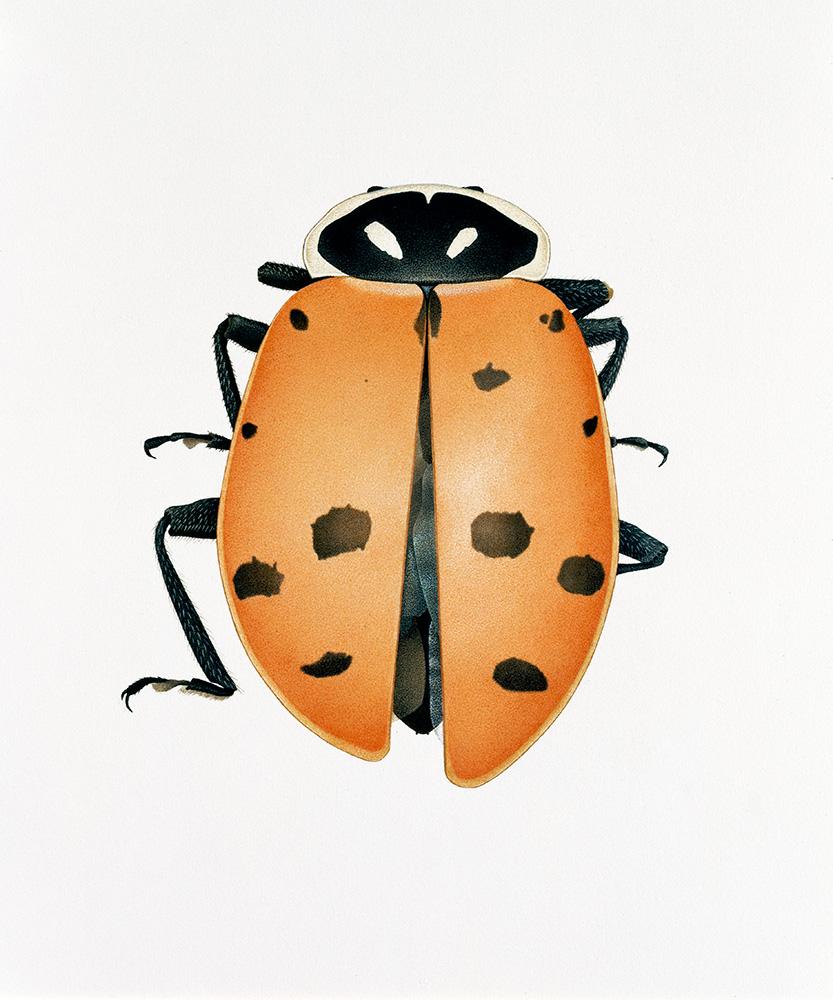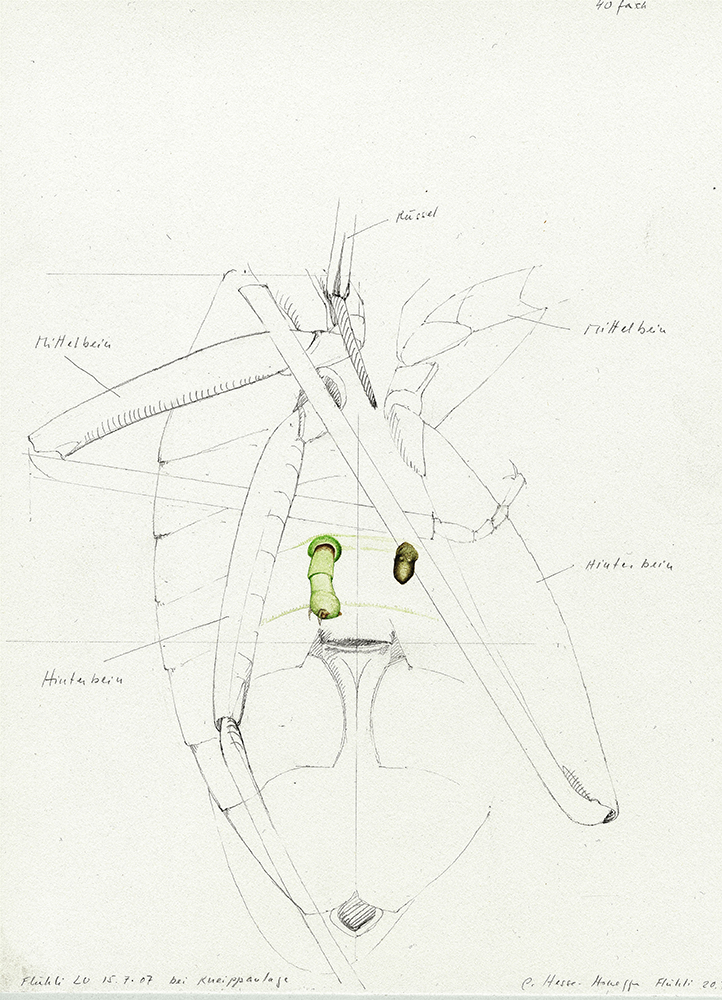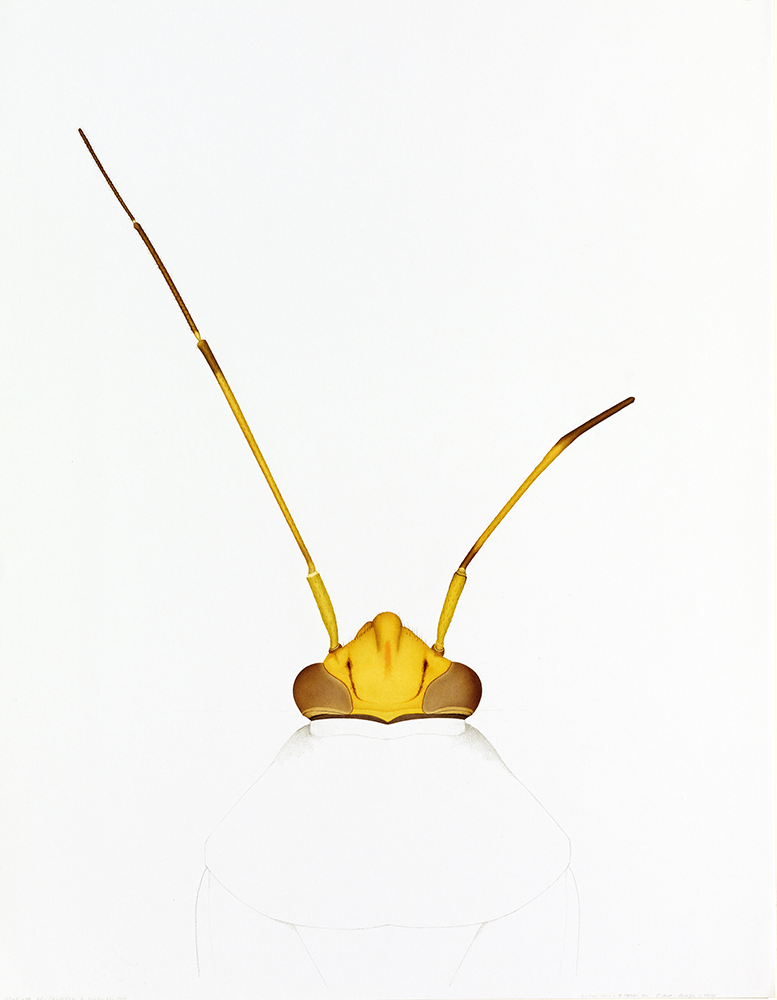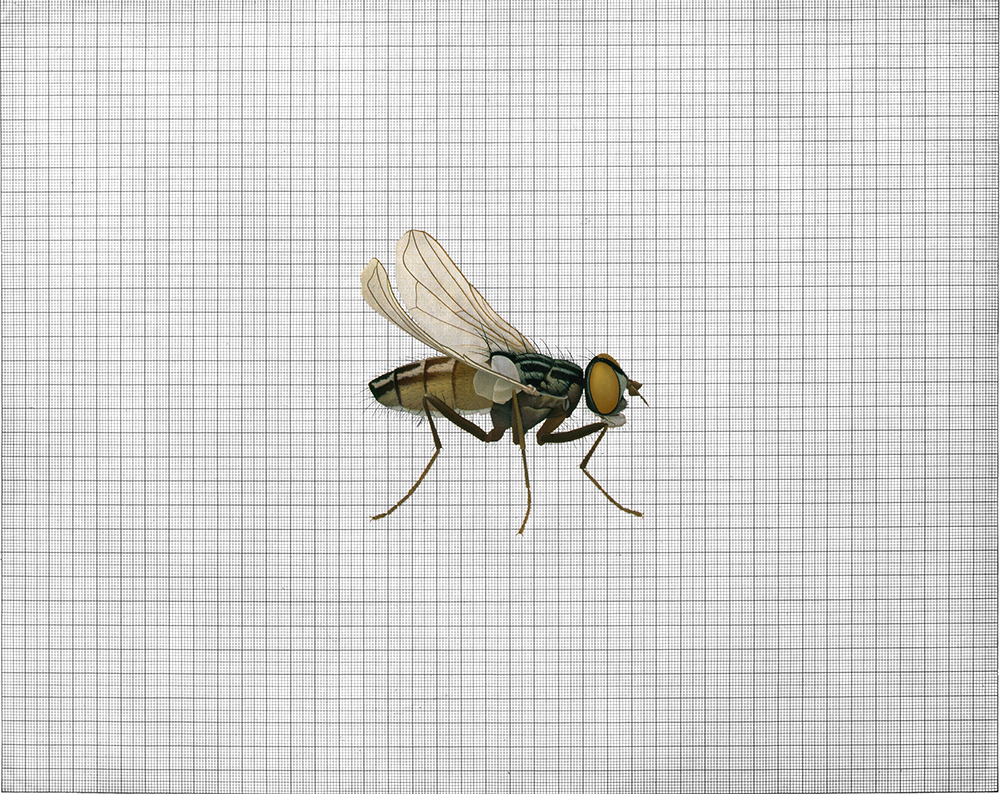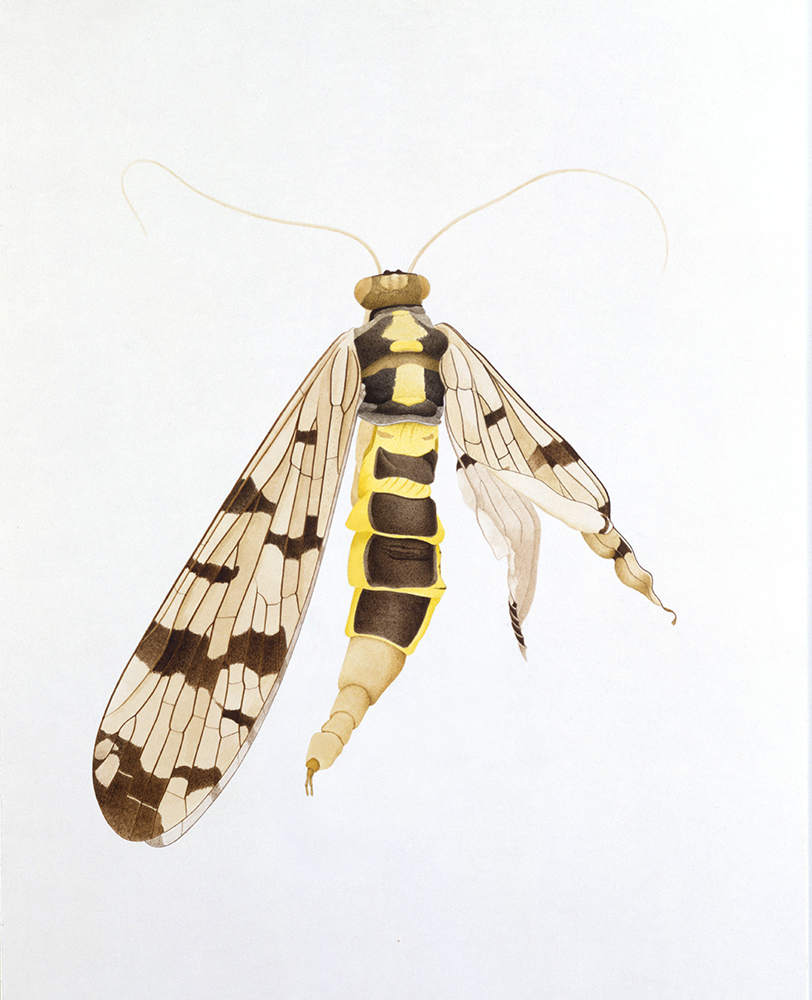When Chernobyl happened, I knew it was time for me to act. Nineteen years earlier, I had first drawn malformed and mutated flies while working in the zoological department at the University of Zurich as a scientific illustrator. Zoologists had fed poison to the flies, called Drosophila subobscura, (Diptera) in order to study how they would mutate. The poison resulted in grossly asymmetrical features of the flies’ offspring. I found the mutated flies so impressive that I began to paint them in my free time. By 1969 I had started my own ongoing private research effort, focused on painting true bugs, of the suborder Heteroptera.
By 1985, the professor I worked for left the university to become a pensioner, and I lost my job. In April 1986, the number four reactor of the Chernobyl nuclear power plant let loose a radioactive plume into the atmosphere that would drift over much of Europe, resulting in an estimated tens of thousands of cancer deaths.
The small-scale laboratory experiments at the University of Zurich were to me like prototypes of a new nature, now being repeated on a vastly bigger canvas. Now I didn’t have to ask scientists in the laboratory to give me particular insects or flies—I could go and find them myself.1
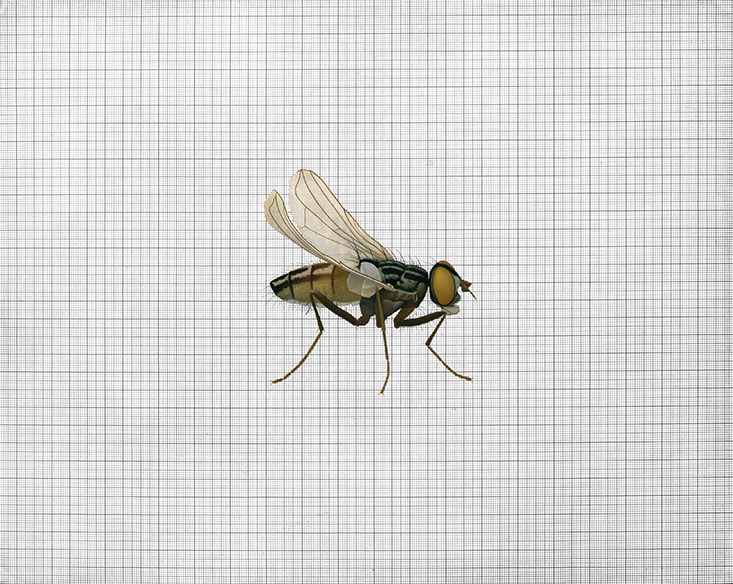
Painting bugs is a personal exercise for me. When I look at my insects through the microscope before I paint them, I find myself almost in a togetherness with them. The insect takes on the character of an important person, and I want to discover everything about it: the texture, the color, the eyes, the wings. My illustration process is slow—it can go on for days or even months—and precise. I measure the whole insect with a centimeter scale in my right ocular. I measure every single part of the creature, its shape as well as its spots and blotches, bristles and claws. I make my first drawing of the insect in pencil and under the microscope. Then I use tracing paper to copy the drawing several times, each time correcting the imperfections. When I finally get a single line drawing on the tracing paper, I copy it with a graphite paper onto watercolor paper, and begin coloring the natural colors of the insect with my brush and watercolors.
The use of illustration and painting in scientific research has been almost completely pushed aside by the advent of photography and machine images. This shift played into a larger discussion about the role of subjectivity and objectivity in science. Scientists love to think that their work is objective, while that of artists is subjective. But I discarded this notion years ago, when, as a scientific illustrator, I had to touch over photographs for my professor. I know about cheating in photography! Drawing has its own ways of revealing the truth. When I was 20 years old, I realized that the act of drawing illustrations for my scientist collaborators allowed me to find mistakes in their thinking. The world I was creating as an artist gave me a unique perspective into the science, letting me see how scientists were affecting their data and interpretations with their own existing biases.
I can present the difference to people in true and exact color, while a photograph may leave a scientist wondering whether the difference is due to some artifact of shadow and lighting.
Painting can also be, in its own ways, more sophisticated, more accurate and more modern than photography. Photography uses concepts that are rooted in ideas from the Renaissance: It defines a space that shrinks to a point as it recedes from the viewer, and it defines a light source and shadow. A more modern conception of space and lighting was conceived in the beginning of the 20th century, with the advent of modern art. It eliminated light and shadow, and the vanishing perspective, instead creating space with color. This means that light and bright colors come forward, and dark and dull colors are kept in the background. (The exception is the “air-perspective,” where for example the mountain that’s closest is painted darkest and the mountain that’s farthest is painted most light.) I grew up in a family with modern artists and modern art, and took in this color perspective without really even thinking about it.
These different perspectives can lead to very real differences in how a scientist or a layperson might interpret an image. For example, suppose one wing of an insect is of a slightly darker red than the other wing due to a disturbance in pigmentation. Where I can present the difference to people in true and exact color, a photograph may leave a scientist wondering whether the difference is due to some artifact of shadow and lighting. I paint the color as it is—or, as we call it, in local color. Before the advent of digital photography, photographs generally allowed only narrow slices of the insect to be in focus at a given time, where my illustrations present the whole insect in simultaneously sharp focus, everywhere.

After Chernobyl happened, I traveled to Sweden, which was also affected by the radioactive plume, to look for mutated bugs. It wasn’t possible to go to Chernobyl right away, because it was part of the Soviet Union. One could not travel there—it was beyond imagination—but I quickly found that there were lessons to be learned in Sweden, too.
I looked specifically for true bugs, which do not pupate. The growing larvae have to molt at least five times and cannot fly at all. Adult true bugs rarely fly, and when they do, they cover very short distances, typically a few meters. They stay near the same piece of ground for generations, making them excellent subjects for the study of the effects of prolonged radiation. They also have a trunk that they use to suck liquid out of leaves. If the plants they feed on are irradiated, the insects take radioactivity into their body, and the effects can be pronounced.
I found terribly deformed insects, even though the levels of radiation there were relatively low. Prolonged, low levels of ionizing radiation, I learned, could have a profound effect on nature. This was contrary to the scientific opinion of the time, but consistent with some independent research.2 In the southern part of Switzerland, which was highly irradiated by Chernobyl, I collected three pairs of Drosophila melanogaster flies and bred them in my kitchen with the same food that we used to use in the university. From the first generation on, the flies were deformed. In 1988, I published this and similar data in the magazine Tages-Anzeiger.3
Nobody was prepared for this. Scientists in Europe considered such deformation to be impossible because radiation levels were too low, and accused me of fear-mongering. They were irritated by my publication, saying that I wanted to act as if I were a scientist even though I was only an artist, who had no right to enter a scientific subject that she did not understand. And it was true: I didn’t understand much of the science, or even know how a nuclear power plant works. But I had studied and painted true bugs since 1969, and had good points of comparison from before Chernobyl. I was just repeating what nature was telling me. Nevertheless, I never held another university job after publication of the paper.
In 1992, I decided to start a systematic study of the effects of nuclear power, traveling to nuclear plants around the world and gathering true bugs living around them. By the end of 2012, I had visited over 25 locations, from Chernobyl to Three Mile Island to Cape de la Hague, and gathered close to 16,500 insects.4 I painted at least 250 insects or insect parts. What I found was that around nuclear power plants, even ones that hadn’t suffered any accidents, the insects exhibited a consistently higher rate of deformations. I also found that wind direction and frequency of direction change were important predictors of deformation, sometimes more important than distance alone. Today, wind frequency and direction are commonly taken into account when considering environmental impacts.
My work has allowed me to discover an aspect of nature by painting it. I couldn’t have done it any other way. I cannot learn and discover through reading or taking in prepared pictures. I can only discover something when I draw and paint it myself. There’s a German word for this style of research work: Wissenskunst or literally, “knowledge-art,” as opposed to Wissenschaft, which is German for science. Art has its own paths to discovery, its own ways of making the unknown visible, one fly at a time.
Cornelia Hesse-Honegger worked as a scientific illustrator for the scientific department of the Natural History Museum at the University of Zurich for 25 years. Since 1986 she has collected, studied, and painted morphologically disturbed insects.
References
1. Hesse-Honegger, C. Heteroptera: The Beautiful and the Other Scalo, Zurich (2001).
2. Yablokov, A. A review and critical analysis of the “Effective Dose of Radiation” concept. Journal of Health and Pollution 3, 13-28 (2013).
3. Hesse-Honegger, C. Wenn Fliegen und Wanzen anders aussehen als sie sollten. Tages-Anzeiger Magazin 4 (1988).
4. Hesse-Honegger, C. & Wallimann, P. Malformation of true bug (Heteroptera): a phenotype Field Study on the Possible Influence of Artificial Low-Level Radioactivity. Chemistry & Biodiversity 5, 499-669 (2008).
Reproduction, including downloading of Cornelia Hesse-Honegger works is prohibited by copyright laws and international conventions without the express written permission of Artists Rights Society (ARS), New York.

























